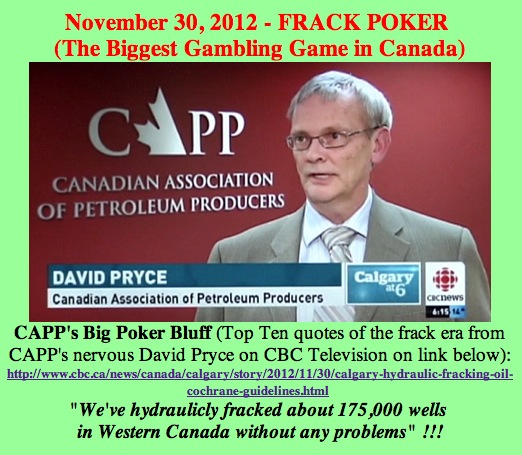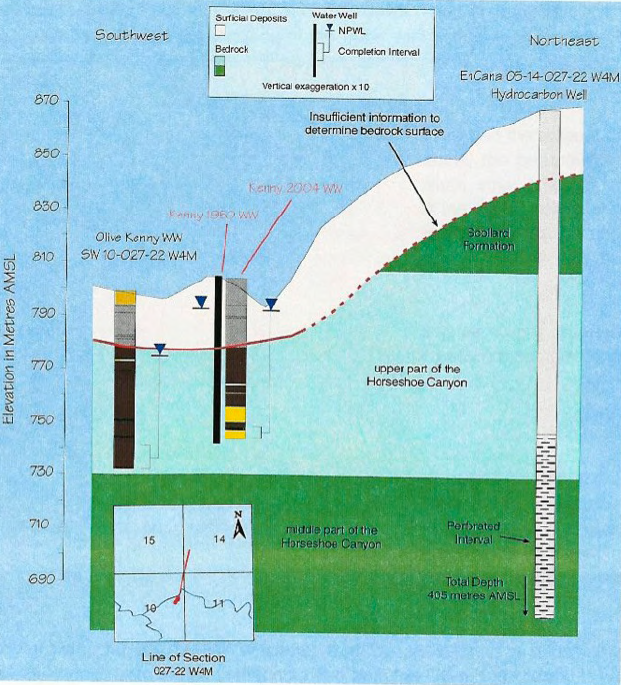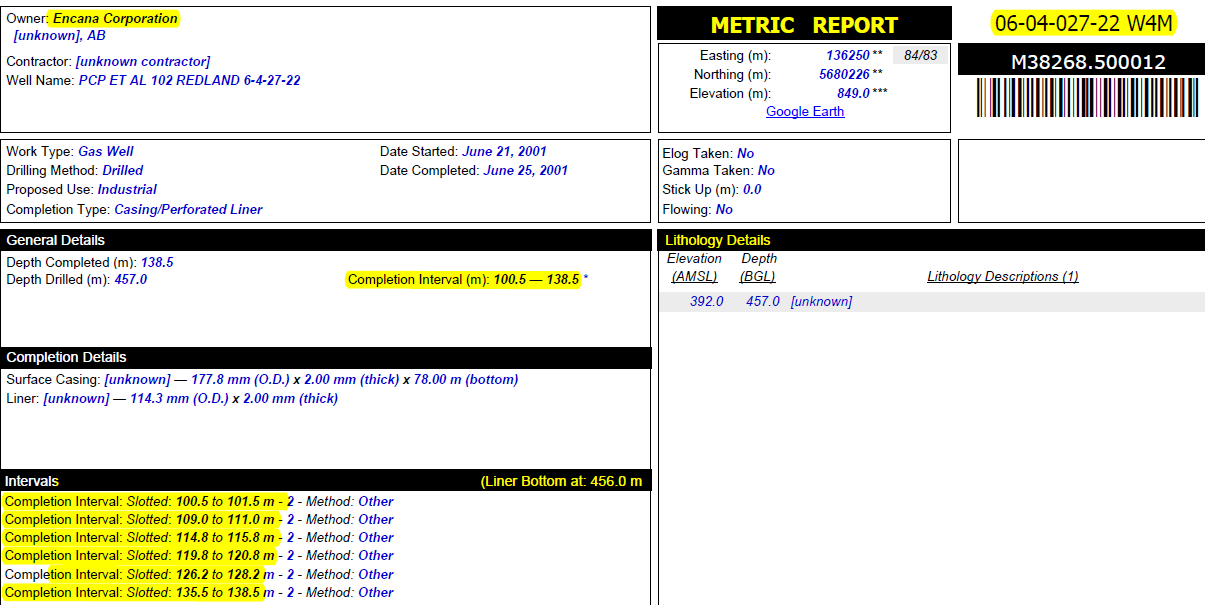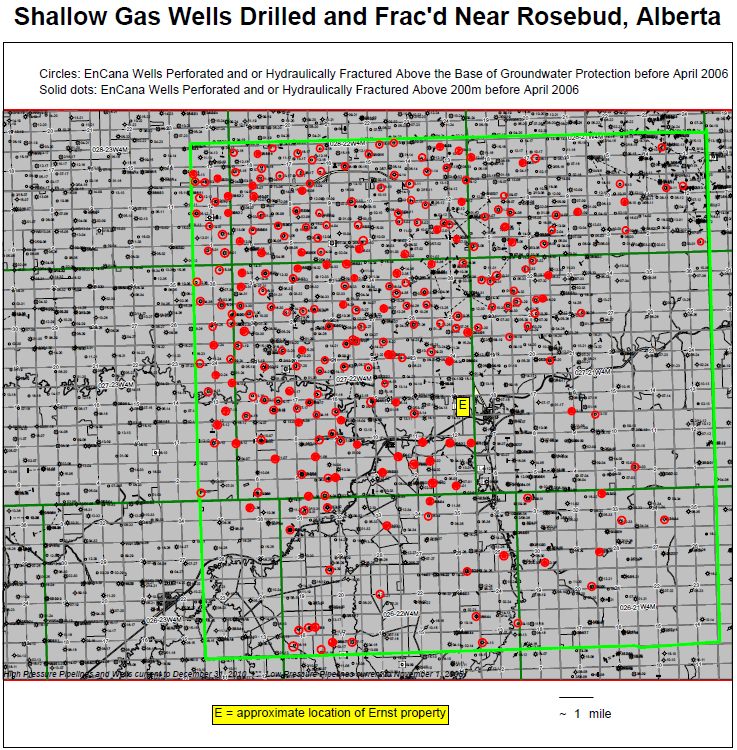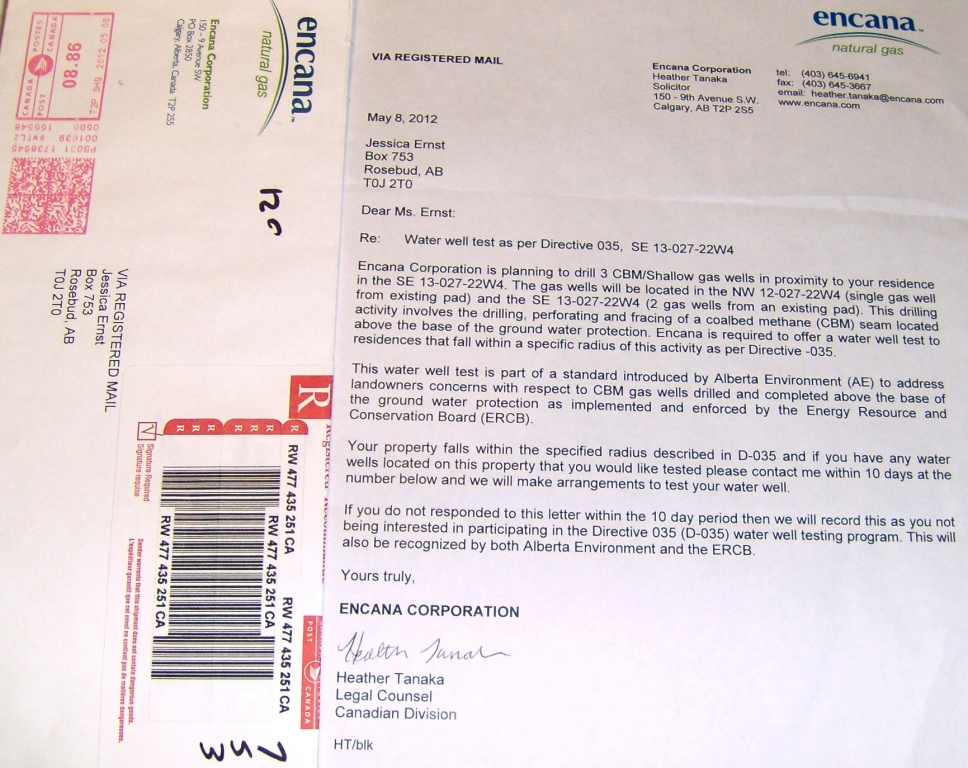Groundwater contaminated after fracking fluid leak in Canada by Boulder Weekly, December 27, 2012
An investigation into a fracking fluid leak near Calgary, in Canada, has confirmed groundwater contamination. On Sept. 22, 2011, Crew Energy Inc. workers “inadvertently perforated above the base of groundwater protection” and proceeded with hydraulic fracturing operations using 130 cubic meters of gelled propane as carrier fluid and 20.07 tons of sand before realizing the fracturing was too shallow, according to a report by Canada’s Energy Resources Conservation Board. The well was flowed back to recover as much of the propane and fracking fluid as possible and two groundwater monitoring wells were installed 50 meters northeast of the drill site. Combustible gas at a level lower than the combustible limit was found in one of the wells. Almost a year later, on Sept. 20, the groundwater composition showed ongoing effects from fracking fluid. [Emphasis added]
Alberta Finds Mismanagement of Errors Causes Fracking Water Contamination by Carol Linnitt, December 22, 2012, desmogblog
“There is no amount of regulation that can overcome human error,” said Alberta’s Energy Resources Conservation Board (ERCB) spokesman Darin Barter. ERCB released an investigation report that cites inadequate management of risks as one of the main causes of a September 2011 accident that contaminated groundwater with toxic hydraulic fracturing chemicals, including the cancer causing agent known as BTEX (benzene, toulene, ethylbenzene, and xylene). The incident occurred near Grande Prairie in northern Alberta when Crew Energy and GasFrac Energy Services workers failed to “recognize and properly assess a number of issues that led to the perforation and fracturing above the base of groundwater protection,” according to the report. Workers accidentally fracked directly into an underground water table after a series of mishandled errors resulted in a massively bungled frack job that injected 42 cubic metres of unrecoverable propane gel into an aquifer some 136 metres below ground.
…
The accident, documented in detail in ERCB’s 19-page report, violated the favoured gas industry assurance that fracking will never occur above base groundwater depths. Oil and gas industry lobby group Canadian Association of Petroleum Producers (CAPP) insists on its public relations website morefactslessfriction.ca that fracking production pipes are “bound by rock and several hundred meters below the deepest fresh water aquifers.” [Natural Resources Canada] writes that “hydraulic fracturing is permitted only well below the deepest freshwater aquifers.”
…
Some of the major incidents involving water contamination – such as the high-profile water contamination case in Pavillion, Wyoming – are related to shallow gas wells, where cement barriers are unable to isolate frack fluids from water-bearing zones, or geological barriers (i.e. rock beds) are insufficient to prevent contaminant migration. In this particular incident operators botched a frack job at roughly 136 metres below surface level, even though the base of groundwater protection was at a depth of 600 metres.
No fines will be levied at the companies responsible for the water contamination.
Ewart: Comedy of errors on frack job no laughing matter by Stephen Ewart, December 21, 2012, Calgary Herald
On Sept. 22, 2011, workers from Crew Energy and service company GasFrac Energy Services attempted to frack a well in a liquids-rich gas reservoir near Grande Prairie in northern Alberta but what happened could be described as a comedy of errors. Except – with the heightened awareness of the environmental concerns with fracking – nobody is laughing. Workers on the well site failed to heed a number of warning signs and inadvertently perforated the well at about 137 metres below surface and delivered high-pressured shots of water, sand and toxic chemicals into the water table rather than the intended gas reservoir more than a kilometre further underground.
The last of seven conclusions in a government regulator’s 19-page report released Thursday cut to the chase. “Crew and the on-site service company’s personnel did not adequately manage the risks … there were multiple opportunities to recognize that a problem existed, which could have prevented or at least minimized the impact of the hydraulic fracturing operation above the base of groundwater protection,” said the Energy Resources and Conservation Board. Crew, meanwhile, said it is “embarrassed” about the incident and has made sweeping changes to its well-site monitoring and fracking practices. It should. Injecting toxic chemicals at shallow depths that could impact the water supply is one of the cardinal sins of fracking. “There’s no question of our appreciation of the severity of this,” said Rob Morgan, the chief operating officer for Calgary-based Crew. “Pretty much all of the personnel who were involved in this particular circumstance are no longer with the company.”
Hydraulic fracturing involves injecting fluids under pressure into underground rock formations to cause cracks to release natural gas or oil. More than 42 cubic metres of propane used by Crew in its fracking process couldn’t be recovered and remains underground. The ERCB required Crew to develop and implement a detailed plan to prevent similar incidents occurring again. Crew must also provide to the ERCB the analysis from groundwater monitoring Alberta Environment is conducting on site. In its own documents to address public concerns on the threats to groundwater, the ERCB states it “has regulations that strictly limit the depth of shallow fracturing, distances to water wells, limit the fracture volumes that can be used and specify the use of non-toxic fracture fluids to ensure groundwater protection.” Inadvertent or not, Crew violated the regulations. However, its marching orders largely amount to working to ensure it doesn’t happen again. Alberta Environment said monitoring indicates only the lower aquifer, which is not used for water supply, was contaminated with propane and other toxins but a shallower aquifer that’s used for some wells in the sparsely populated area wasn’t affected. Neither the ERCB nor Alberta Environment intends to fine Crew or GasFrac.
The regulator said such incidents are rare among the 5,000 fracturing operations in Alberta since 2008. Spokesman Darin Barter notes the ERCB’s ability to issue fines is limited and there is a bigger impact from halting production. “What we’ve found over 75 years when you slow down a company or stop a company from performing their business there is a bottom line impact,” Barter said. “Although there isn’t fine … the industry becomes safer when we insist the company move forward with action plans.” In this case, the $5 million Crew spent on the well produced a dry hole. Technologies to develop unconventional oil and gas, such as fracking, have proliferated across North America recently but have proved controversial. Fracking has been linked to groundwater contamination and causing small earthquakes. This month the ERCB released a draft directive to address subsurface issues around fracking and invited public comments in its review. The Canadian Association of Petroleum Producers has voluntary guidelines for its members that urge using additives with the least environmental risks, protection of groundwater, and disclosure of fracking fluids. Crew, a mid-sized oil and gas producer, acquired the well in its takeover of Caltex Energy in July 2011 and said the operations were being integrated when the incident occurred. Morgan acknowledged that “we’re embarrassed that it came under the Crew name and obviously very sorry.”
Last week, the ERCB concluded a well blowout near Innisfail last January that spewed 500 barrels of oily liquid over a field was caused by a company fracking a nearby well. It said “communication” between a well fracked by Midway Energy and a nearby well operated by Wild Stream Exploration caused the blowout. No enforcement order was issued because the action didn’t violate regulations in place at the time.
Barter said the problem at Crew’s well was that people misread or ignored pressure gauges or other indicators that signalled something was wrong. “There is no amount of regulation that can overcome human error,” he said. True, but at least some fine from the government could reinforce the safety messages from the top executives to the bottom line. [Emphasis added]
Leaked fracking fluid contaminated groundwater near Grande Prairie: ERCB by Sheila Pratt, December 21, 2012, Calgary Herald
Leaked fracking fluid has contaminated groundwater after a “serious” incident at a well site near Grande Prairie in September 2011, according to an investigation by the Energy Resources Conservation Board which regulates the energy industry. Calgary-based Crew Energy “inadvertently” released toxic fluids at too shallow a level in a natural gas well and then failed to realize the leak was occurring underground, said the ERCB report released Thursday.
Energy Company Reprimanded By ERCB After 2011 Fracking Incident Near GP by Sara Buchan, December 20, 2012, hqgrandeprairie
Calgary-based Crew Energy has been hit with a ‘High-Risk Enforcement Action’ over a hydrualic fracturing incident near Grande Prairie last year. The Energy Resources Conservation Board released its investigation Thursday, saying the company broke rules regarding fracking at a shallow depth, which put groundwater at risk. ERCB spokesman Darin Barter says the company was made aware of how serious the infraction is. “We met with Crew Energy this morning and handed them the High Risk Enforcement Action letter which requires a number of tasks for them to complete. Including an action plan on how the company will avoid.” The gas well in question is in a ‘remote’ area on Crown land, Barter says, and remains shut down. Environment and Sustainable Resource Development is over-seeing water testing and so far no shallow impacts have been found, but Barter says some fracking fluids did turn up in water samples from the deep well.[Emphasis added]
ERCB: New rules coming for fracking and unconventional resources by Suzy Thompson, December 20, 2012, Fast Forward Weekly
The Energy Resources Conservation Board (ERCB) is in the process of a large-scale review of its fracking regulations, with changes implemented sometime in 2013. The ERCB is specifically concerned with water aquifer protection, preventing above-ground chemical spills, and interwellbore communication. “That’s when you have two oil or gas wells that are close enough down-hole that there is some sort of impact on one due to activities in the other well,” explains ERCB spokesperson Bob Curran. That kind of underground communication between Midway Energy’s fracking operation and a nearby well operated by Wild Stream Exploration caused a blowout near Innisfail last January. At their closest point, those two wells are 129 metres apart. When the pressure that built up in one escaped to the other bore-hole, fracking fluid leaked to the surface. Curran says that since the ERCB began monitoring interwellbore communication this year, there have been 21 incidents, but they rarely cause damage. … Curran says geologists understand the technology and its potential consequences quite well, and that the ERCB is not struggling to align rule-changes with a poorly developed science. “Hydraulic fracturing as a technology is very well understood, and it’s been applied here extensively in Alberta over our history…. There’s been over 171,000 wells that have been hydraulically fractured in Alberta since the practice began in the 1950s,” he says. Curran says it’s this understanding of the technology, Alberta’s geology, and a long-standing “stringent” regulatory system that have prevented negative incidents in Alberta that are making headlines in other parts of the continent.
…
While the ERCB is confident in the safety of fracking, the matter is still up for debate elsewhere. Dr. David Layzell, the head of the University of Calgary’s Institute for Sustainable Energy, Environment and Economy, says there are significant questions about the technology. “We do not have good peer-reviewed data from controlled experiments on the costs, benefit and trade-offs (environmental, economic, risk) of the various fracturing technologies. We also need independent, arm’s-length analysis of the greenhouse gas emissions (especially methane) that typically occur during the fracturing process. Some studies have suggested that these emissions can be quite high, while others provide data suggesting that the emissions are insignificant. Most of the evidence to date suggests that there are few environmental impacts associated with the fracturing itself. The problems that have arisen seem to come from spills at the surface, poor integrity of the well casing, or re-injection/disposal of the spent fracturing fluids creating small seismic events,” Layzell explains by email. He calls on the U.S. National Academy of Sciences, Royal Society of Canada, and Canadian Council of Academies to take the lead in designing and carrying out studies in order to avoid conflict of interest and other issues that have arisen from industry and university-led research. It’s not that studies haven’t been conducted — many have — but contradictory findings and questionable research practices have led many of them to cancel each other out. In February 2012, Layzell participated in a panel discussion at the American Association for the Advancement of Science conference in Vancouver on fracking’s effect on water quality. The research that discussion was based on was a highly publicized University of Texas study that found no link between fracking and water contamination. The paper suggested public anxiety over fracking was based on biased media reports rather than scientific evidence, and concluded regulatory regimes need not be changed. In the following months, the University of Texas discovered the lead researcher, Dr. Chip Groat, sat on the board of a fracking company while authoring the paper. A subsequent university review declared “the design, management, review and release of the study… fell short of contemporary standards for scientific work,” and that the study was “inappropriately selective in the use of material.” Ironically, that study was originally supposed to be funded by an oil company, but funding was rejected when the company insisted it be allowed to vet the final report.
The study has since been trashed and Groat has left the university, yet even solid science remains inconclusive. The surface, groundwater and air pollution associated with fracking is unknown. High-pressure wastewater storage wells may or may not be causing earthquakes. Specific chemicals used in fracking fluid are a mystery in many jurisdictions. Curran says industry has long been obligated to disclose to the ERCB what is in the injection fluid, and Layzell says it is well known that water, carbon dioxide, nitrogen and propane are most commonly used. “What we’ve seen is some jurisdictions where there’ve been problems, there have been regulatory gaps,” Curran insists. It is “because of that some of these accidents have occurred. And in Alberta those regulations are already in place to prevent that from occurring.”
Leaking fracking fluid contaminated groundwater near Grande Prairie: ERCB Investigative Report and groundwater monitoring by Alberta Environment by Sheila Pratt, December 20, 2012, Edmonton Journal
Leaked fracking fluid has contaminated groundwater after a “serious” incident at a well site near Grande Prairie in September 2011, according to an investigation by the Energy Resources Conservation Board which regulates the energy industry. Calgary-based Crew Energy “inadvertently” released toxic fluids at too shallow a level in a natural gas well and then failed to realize the leak was occurring underground, said the ERCB report released Thursday. “There were multiple opportunities to recognize that a problem existed which could have prevented or at least minimized the impact of hydraulic fracturing operation above the base of groundwater protection,” says the report. While a drinking water source near the surface was not affected, a groundwater basin below it was contaminated, said ERCB spokesman Daren Barter, adding this is considered a “serious” if rare incident. The ERCB gave the company a “high risk enforcement action” ordering it to supply a revised fracking plan. … Only non-toxic fluids can be used above the base of groundwater. The level is set for each region by Alberta Environment. About 40 cubic metres of the propane gel injected underground remains there, so no drilling is allowed in a 200-metre radius of the well site. Alberta Environment tested the contaminated water this fall and found chemicals from fracking fluid, including benzene, toluene, ethylbenzene and chloride. A sandstone layer separates the two water sources so the risk to drinking water was deemed “insignificant,” says Alberta Environment. Alberta Environment will continue to monitor the contaminated water “for some time” to make sure the toxic fluids do not migrate or spread underground, said department spokesperson Jessica Potter. If that happened, “we would have to deal with it,” she added.
Rob Morgan, a Crew Energy executive, said his company contracted the fracking at the well site to Caltex Energy Inc., while the operation was monitored at the Crew Calgary office. Some some staff have been replaced, he added. The company has been working with the ERCB and the environment department since the incident and has already changed its fracking process to avoid a recurrence of the problem. Toxic fluids are now put down the well casing and cannot be released until ports or openings in the casing are far enough underground, he said. Barter also said the ERCB did not release details of the incident at the time because the location was considered remote and there was no impact on the public. The ERCB rarely issues a fine, and instead gets the situation corrected, said Barter. If a company fails to comply, the well operation could be temporary suspended, he added. [Emphasis added]
ERCB RELEASES INVESTIGATION REPORT ON HYDRAULIC FRACTURING INCIDENT NEAR GRANDE PRAIRIE News Release by ERCB, December 20, 2012
The Energy Resources Conservation Board (ERCB) has issued its investigation report that includes details of a High-Risk Enforcement Action against Crew Energy Ltd. for a hydraulic fracturing incident that occurred near Grande Prairie on September 21, 2011. The ERCB investigation concludes that Crew Energy improperly perforated and hydraulically fractured at a shallow depth. In issuing high risk enforcement the ERCB noted the following regulatory non-compliances:
– Failure to use only non-toxic fracture fluids above the base of groundwater protection; and
– Failure to recognize and properly assess a number of issues that led to the perforation and fracturing above the base of groundwater protection.
As a result of enforcement action being taken, the ERCB required the company to develop and implement a corrective action plan that details measures to prevent similar incidents from occurring in the future. The ERCB is currently auditing the company’s action plan. Additionally, Crew is required to provide all analysis from its Alberta Environment and Sustainable Resource Development directed groundwater monitoring program to the ERCB. Incidents of this nature are very rare. More than 171,000 oil and gas wells have been hydraulically fractured in Alberta since the 1950s. In recent years, more than 4,000 multi-stage hydraulic fracturing operations have been conducted in Alberta. … The company is now required to conduct ongoing groundwater monitoring in the area and to develop and implement a plan that details measures to prevent similar incidents.
ERCB Investigation Report: Caltex Energy Inc., Hydraulic Fracturing Incident, 16-27-068-10W6M, September 22, 2011 by the ERCB, December 20, 2012
1 Description of Incident
On September 22, 2011, Crew Energy Inc. (Crew) was performing a hydraulic fracturing operation on the Caltex HZ ELM 11-34-068-10W6M (actual bottomhole location) well and inadvertently perforated above the base of groundwater protection at a depth of 136 metres measured depth (mMD). Hydraulic fracturing operations were subsequently conducted using gelled propane as a carrier fluid, pumping 20.07 tonnes of sand and 130 cubic metres (m3) of gelled propane. When it was realized that hydraulic fracturing had occurred through the shallow perforations, flow-back operations of the fractured interval were conducted. A two-well groundwater monitoring program was initiated and is ongoing to evaluate the impact of the incident upon groundwater. The monitoring wells are located approximately 50 metres (m) northeast of the surface location of the hydraulically fractured well located at LSD 16-27-068-10W6M. This location was recommended by Crew and accepted by Alberta Environment and Sustainable Resource Development (ESRD) based on the hydraulic gradient and expected aqueous transport direction.
Chronology of Events
September 21
• The well was filled with fluid to circulate out debris.
September 22
• The perforating gun was run in on coil and the well was perforated.
• The coiled tubing collapsed.
• Coiled tubing was re-run in and the well was blown dry with nitrogen.
September 23
• Propane fracturing conducted.
• The bridge plug was set but the casing failed a pressure test.
September 24
• A downhole packer was run in to conduct pressure isolation tests. Perforations were confirmed to be between 130 and 150 mMD
September 25
• A downhole camera was run in to determine the exact location of the perforations; they were found at 136.21 mMD
• Begin flowing well.
September 26 – October 9
• Well continued to flow.
October 10 – 14
• No operations.
October 15
• Squeezed cement plug into the perforations at 136 mMD.
2 Investigation
Crew findings are largely captured in Appendix A: Crew Energy Root Cause Analysis and supplemented with information provided throughout the investigation.
The investigation included
• an incident report prepared by Crew immediately following the incident,
• a meeting with Crew, ESRD, and the Energy Resources Conservation Board (ERCB) on February 9, 2012, to review the incident data, the groundwater monitoring plan, and Crew’s activities to manage the 16-27 hydraulic fracturing operation, and
• a follow-up meeting with Crew and the ERCB on February 23, 2012, to allow Crew to provide the ERCB with their plans to better manage the risk with future high vapour pressure (HVP) hydraulic fracturing operations.
2.1 Change of Fluid
2.1.1 Observations
Debris in the wellbore following an earlier stage of the fracturing operation at a depth of 1650 mMD caused the running of a bridge plug to not reach the planned setting depth. The debris resulted in the addition of the step to circulate the well with potassium chloride (KCl) water to remove the debris from the well. As a consequence, the well was left fluid filled rather than gas filled as called for in the completions program.
2.1.2 Crew Findings
A program deviation necessitated the well be circulated to water prior to perforating.
2.1.3 ERCB Findings
A change occurred to the coiled tubing perforating plan where the well was filled with KCl water instead of the nitrogen originally planned. This change would have caused the wellbore to have lower compressibility due to the presence of the water when stripping and snubbing the coiled tubing perforating gun into the well. Consequently, pressure build-up would have been more rapid compared to a nitrogen-filled well. …
2.3 Perforating Gun Fires Off-Depth
2.3.1 Observations
At approximately 137 m, the depth where the perforations were found, the coiled tubing jumped on the reel while stripping in. This was interpreted to be a coil wrap problem on the coiled tubing reel. The possibility that the perforating gun had fired at this depth was not recognized at the time.
2.3.2 Crew Findings
The jump of the coiled tubing at 137 mMD was interpreted by Crew personnel as being a loose wrap on the coiled tubing reel.
2.3.3 ERCB Findings
The coil jump at 137 mMD is the first evidence of off-depth perforations. The possibility that the perforating gun had fired at this depth while running in was not considered at this point.
2.4 Perforating Gun Attempted Firing
2.4.1 Observations
The perforating gun was run to the planned depth of 1486 mMD and pressured up to perforate the well. The firing head was shear-pin-pressure activated and set to fire at 27 330 kPa. The observed pressure was 17 000 kPa, more than 10 000 kPa below the design pressure. This difference was not acknowledged as being a significant deviation, nor was it recognized as an indicator that the well might not have been perforated at the planned depth.
2.4.2 Crew Findings
The service company providing the perforating service interpreted the 17 000 kPa as the perforating guns having fired at depth. During the Crew investigation, the service company stated this pressure was normal. Testing of an identical firing head by the manufacturer demonstrated the head should have fired within 5% of the design pressure (26 000 to 28 700 kPa).
2.4.3 ERCB Findings
The 17 000 kPa observed pressure was not acknowledged during the operation by the service company or by Crew supervision as being significantly below the set pressure. This should have been recognized as the second indication of the premature firing of the perforating gun. …
2.6 High Vapour Pressure Fracturing
2.6.1 Observations
HVP fracturing using propane was conducted; nobody was yet aware that the perforations were at 136 mMD. The peak hydraulic fracturing surface pressure (42.9 megapascals [MPa]) was mid-range to the other intervals fractured in this well. The overall pressure response was recognized by the GasFrac supervisor as being unusual, as it declined during the operations and the well had a low shut-in pressure when the treatment was finished. (GasFrac Energy Services is the service company that provided the fracturing pumping services and the gelled propane fracturing fluid.)
2.6.2 Crew Findings
None.
2.6.3 ERCB Findings
The GasFrac supervisor’s recognition of the low shut-in pressure and the declining stimulation pressure did not apparently trigger a question at the time as to whether or not there was a problem with this particular fracturing stage or that there may have been any outof-zone communication. …
2.8 Misplaced Propane
2.8.1 Observations
Having confirmed the well had been fractured at the perforations at 136 mMD, the well was flowed back to recover as much of the propane and fracturing fluids as possible. Approximately 42 m3 of propane was not recovered. Groundwater monitoring wells were installed to investigate the movement of the fracture
fluids in the subsurface. Two monitoring wells were installed: one completed at the depth of the perforations (137 mMD) and the other in the overlying sandstone seam considered to be a potential domestic use aquifer (DUA) at the depth of 81 metres below ground level (mbgl). The monitoring wells were installed as a nested pair approximately 50 m north of the surface location of the Crew well. Combustible gas, assumed to be propane, was detected at surface on the deeper well using a combustible gas detection meter (LEL). However, the gelled propane chemicals were not identified in the fluid samples collected from this well. …
4.1.2 Monitoring Program
The long-term instrumentation, monitoring, and sampling program for the site is pending based on the results of the pumping tests and ESRD’s approval. Combustible gas was detected through lower explosive limit (LEL) measurement at the surface during the pumping and water sampling tests in the deeper monitoring well Crew was required to report the detection of combustible gas to the ERCB. In addition to the routine components, the deeper monitoring well is likely to continue to be tested for isopropanolamine, being the selected indicating chemical for the presence of the fracturing fluids.
The sampling event in February 2012 detected the presence of isopropanolamine in a sample collected from the deeper well; however, isopropanolamine was not detected in either monitoring well in the samples collected on September 20, 2012. The total Kjeldahl nitrogen (TKN) and ammonia concentrations both showed a significant decrease to one-fifth of the previous concentrations, possibly indicating the attenuation of the amines as well.
The groundwater composition on September 20, 2012, continued to be impacted by the fracturing fluids. The concentrations of chloride has decreased from the February 2012 sample, but remains elevated. Benzene, toluene, ethylbenzene, and xylene (BTEX) concentrations remained unchanged between the February and September 2012 sampling events. The petroleum hydrocarbon (PHC) fractions F2 through F4 concentrations overall decreased (with the PHC fraction F1 showing an anomalous increase). An increase in iron concentrations and a decrease in nitrate concentrations between February and September 2012 is potentially due to the biodegradation of the hydrocarbons as conditions become more anaerobic. A significant increase is noted in the concentrations of dissolved organic carbon (DOC) and phosphorous, potentially related to biological activity.
Further sampling is needed to establish statistically significant trends in the indicator parameters’ concentrations. No compounds indicating the presence of the fracturing fluids were detected in the shallow monitoring well in either the February or September 2012 sampling events. [Emphasis added]
[Refer also to:
Source: Midwest Energy News Petroleum engineers in the 1960s and 1970s tried using propane fracking, but the potential for explosion — which is still a risk today, if better managed — left the technology uneconomical. … Offering an explanation for the dearth of public data on GasFrac’s work for other companies, Robert Lestz, the company’s chief tech officer, said, “Because our results our so superior to what people have done before, they’re not interested in sharing those results.”
Stock slides as GasFrac parts ways with top managers, Waterless well stimulation company promises to repair financial woes September 11, 2012
Fracking safety concerns a festering issue by Stephen Ewart, December 3, 2011, Calgary Herald
In response to a question Wednesday, Alberta Environment and Water Minister Diana McQueen said her staff were engaged in policy discussions with other government departments “before we move heavily into fracking.”…Is the province getting ahead of the issue or not? Is it developing a “comprehensive plan” to regulate fracking as McQueen contends, or adhering to Morton’s assertion that under existing policies “there’s not one documented instance of where the fracking itself led to contamination?” [Emphasis added]
How dangerous is hydraulic fracturing? by Alexandra Rabbitte, November 16, 2012, The Calgary Journal
Fears only ‘theoretical’ says Energy Resource Conservation Board member … Freeman said, “The chemicals injected into the ground are no worse than using fertilizer…or by cleaning your coffee machine with CLR.” … “I don’t think there have been any incidents in Alberta where fracking has adversely affected a water table…,” McManus [vice chair of the Energy Resource Conservation Board in Alberta] said.
Fracking regulations stringent, misconceptions abound by Barbara Duckworth, The Western Producer, February 23, 2012
Bob Curran of the ERCB said ground water protection, drilling and hydraulic fracturing are highly regulated. “Some of the complaints are based on what is happening in other jurisdictions. Their regulations are not the same as ours,” he said. “We have very clear and stringent regulations in place that are protective of ground water regardless of what type of well you are drilling.” … “It is just because of problems in other jurisdictions that suddenly it has come to the fore here, but we haven’t experienced any of those problems here in Alberta.” [Emphasis added]
Source: StopFrackingBC: Frack Poker (The Biggest Gambling Game in Canada)
URF: What are the impacts on water by the ERCB, Spring 2012 There has not been a documented case of direct contamination due to hydraulic fracturing in Alberta.
EnCana’s Multiple Shallow Fracs into Fresh Water Aquifers at Rosebud, Alberta, March 2004
Source: EnCana Corporation Site Investigation Report by Hydrogeological Consultants Ltd., January 2005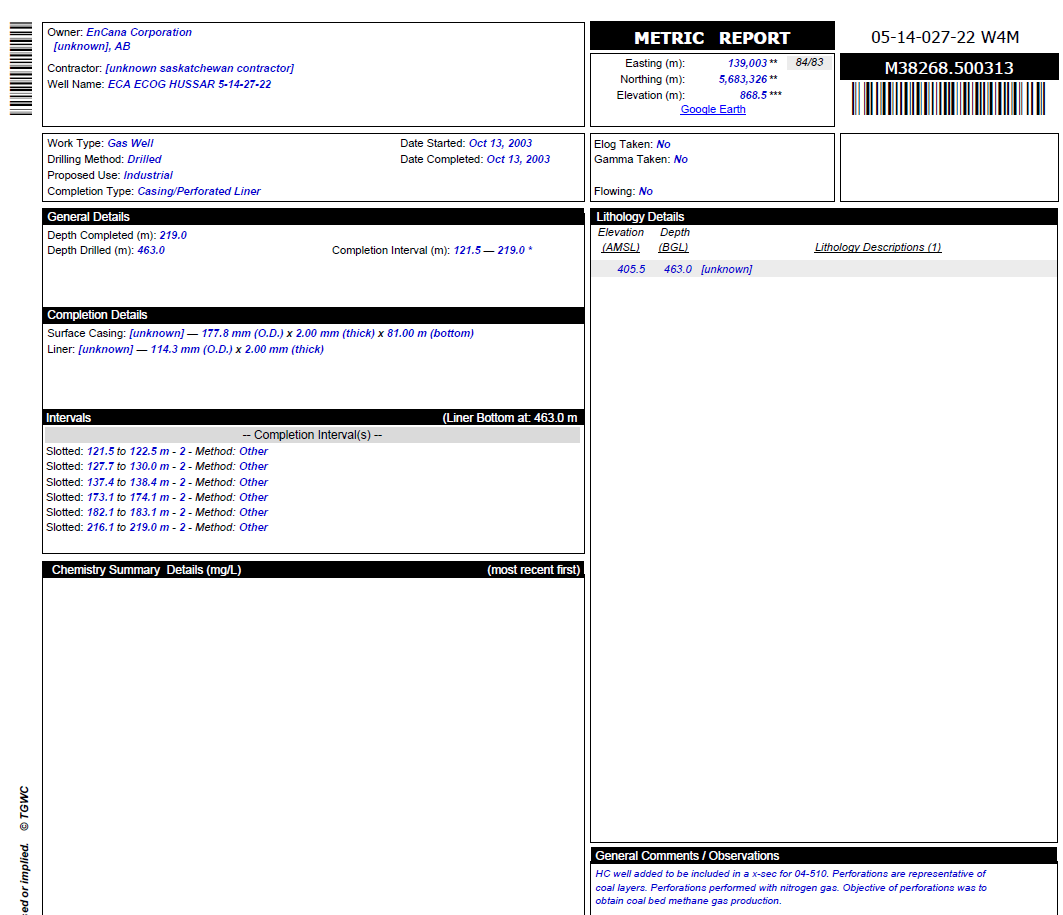
Text in bottom right hand corner of EnCana’s data: “Perforations performed with nitrogen gas. Objective of perforations was to obtain coal bed methane gas production.”
EnCana’s intentional perfs and fracs into Rosebud fresh water aquifers, Source: Alberta Groundwater Centre
EnCana’s intentional perfs and fracs into Rosebud fresh water aquifers, Source: Alberta Groundwater Centre
EnCana’s intentional perfs and fracs into Rosebud fresh water aquifers, Source: Alberta Groundwater Centre
EnCana’s intentional perfs and fracs Above the Base of Groundwater Protection at Rosebud, Alberta – before April 2006, many more wells continue to be intentionally perforated and frac’d Above the Base of Groundwater Protection within the map area and beyond.
Slide from: Is hydraulic fracturing safe and sustainable? Presentation by Jessica Ernst on May 3, 2011 in New York at the United Nations 19th Commission on Sustainable Development.
Click to get PDF, zoom in for legal land descriptions. Black are deeper energy wells.
December 15, 2012: Terroco Oilfield Services, Calfrac (CWS) intentionally fracing EnCana 14-12-27-22-W4M Above the Base of Groundwater Protection on a deviated wellbore near dangerously contaminated water wells at Rosebud, including the Ernst well
As for fracing in the Horseshoe Canyon, says Knull, “we just use nitrogen.” Source: Burning Water


